40 years since the darkest day in Clinton County history, April 3, 1974 … Eight were killed in county’s worst ever disaster
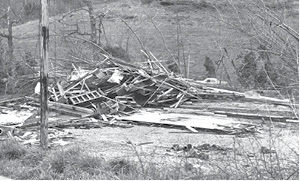
The backside of a piano was about all that was recognizable in this photo of the Mt. Union Church near Seventy Six Falls. The church has since rebuilt and still holds services today.
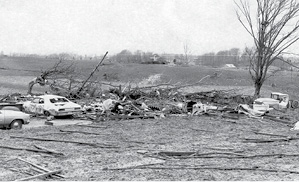
Three members of one family, Cletis Boils, his wife Betty Faye Boils, and their 10 year-old son Michael were all killed at their home shown above in the Ida Community. Another son, Lonnie, was seriously injured.
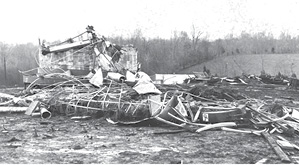
The base of a silo was all that was left with the adjacent barn being completely destroyed by the April 3, 1974 tornado. Farms across the path of the storm had similar sights with several barns and outbuildings being completely leveled and scattered across large debris fields. The above scene was in the Highway Community.

People searching for belongings was a common sight across the tornado path in the days that followed the April 3, 1974 tornado in Clinton County. Above, a couple search through what was left of the Gale Parrigin home in the Green Grove Community.
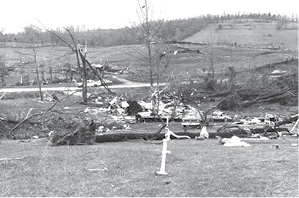
Mobile homes belonging to Hershel Burchett and Billie Tuggle, situated near the Old Ida School building, were destroyed and scattered across a wide debris field in the Ida Community.

Debris from the mobile home where Billy Tuggle lived was scattered for several hundred yards and mixed in with debris from other nearby homes and barns near the intersection of U.S. 127 and Ky. 1590 in the Ida Community.
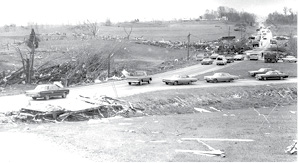
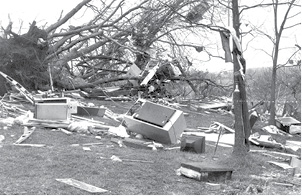
Above, only debris and appliances remained where the Roger Daniel home stood in the Ida Community when the April 3, 1974 tornado struck.
Below, the debris field was spread for several hundred yards near the Green Grove home where William Bradley Ooten was killed.
In the bottom photo, the scene at the Seventy Six Falls park showing downed trees and only the supports for the bridge remained.
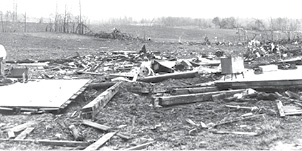
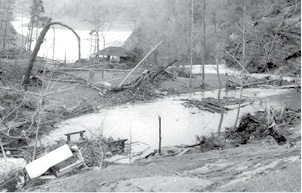
Clinton County is seldom thrust into the national spotlight – one of the reasons that many of its 10,000 or so residents choose to live here – but that wasn’t the case on April 3, 1974, this date 40 years ago today, when it joined communities across a 13-state area that were stricken by one of 148 tornadoes that touched down during a 24 hour period.
Later termed a “Super Outbreak” by the National Weather Service, that day proved to be the worst single outbreak of tornadoes ever and remained the worst ever until an outbreak in April, 2011, surpassed it.
In the 40 years that have come and gone since that “black Wednesday” for Clinton County and much of the rest of this region of the country, many of the residents who were alive to witness the event or were involved in the cleanup following the outbreak, have died.
In their place has grown an entire new generation of residents who only have stories that were passed down from their elders about the events that Clinton County suffered on that late afternoon in 1974.
Time has also erased most of the evidence of the storms that swept across Clinton County from the west to the east. Fallen trees have rotted away and downed structures have been removed, rebuilt or abandoned.
One of the most lasting reminders of the tornado strike here was a large, medal livestock trough that had been blown high into a tree on the Seventy Six Falls Road near the Mount Union Christian Church.
That trough remained stuck in the tree for 39 years, falling to the ground only last summer when the branch holding it finally gave way from the decades of struggling to grow around the foreign object.
Rescue efforts began almost immediately after the tornado had passed through, and continued throughout that Wednesday night and throughout the day Thursday, with emergency workers, law enforcement, rescue squad members and volunteers from not only this county, but other nearby counties as well, combing through destroyed homes and buildings looking for survivors – those injured and those just trapped and unable to free themselves.
The level of outpouring of those who immediately went out into the darkness to assist in the rescue efforts was described in the next issue of the Clinton County News that followed the 1974 storm:
“Hundreds of volunteers, including rescue squads from several counties, the Red Cross, Civil Defense, RECC workers, telephone line repairmen, National Guard, county and state (law enforcement) officers, ambulances, welfare workers, workers from garages, bulldozers, tractors, trucks, chainsaws, in fact people from every walk of life, have been pushing forward since Wednesday night of last week with their efforts to help the victims of the lethal tornado which smashed through the county late Wednesday, April 3.”
The rescue searchers that night found plenty – a host of people who had been injured from the effects of the tornado.
In the next issues of the Clinton County News following the 1974 storm, it was reported that 16 local residents were admitted to the Clinton County Hospital for treatment of injuries suffered in the tornado, while five more Clinton County residents were admitted to the Cumberland County Hospital and two from here were admitted to the Glasgow Hospital.
In addition, some 14 local residents were treated and released at the Clinton County Hospital while 16 more from here were treated and released at the Cumberland County Hospital.
Those helping to search through damage also made a far more grim discovery as the rescue efforts went on.
Eight people from Clinton County had lost their lives in that deadly storm that moved through.
One of the victims who was seriously injured, Lonnie Boils, lost part of both legs as a result of his injuries. Even more disastrous was the fact that he also lost both of his parents and a brother, all victims of the tornado.
Cletis B. Boils (42), Betty Faye Boils (36) and their 10 year-old son, Michael Boils, were all killed that night when their home was destroyed in the Ida Community of central Clinton County.
Another mother and son, Florence Hoover (66) and Jack Hoover (38) were killed in their Piney Woods home.
Ellen Brown (63) died in the Upchurch Community near Seventy Six, Effie Wells (64) died at her home in Seventy Six, and William Bradley Ooten (87) was killed in his home in the Green Grove Community.
It was reported that some of the bodies of the victims were discovered hundreds of feet from the locations of their homes.
Another Albany native, Eula Lee Garrett (56), and her husband, Coy Garrett, died that same night when a tornado struck their home near Moodyville, Tennessee.
Although reports conflicted at the time, it has been officially listed that over 50 homes were destroyed or heavily damaged in Clinton County alone, with at least an equal number of barns and outbuildings being destroyed that night.
The tornado, or likely at least two separate tornadoes that swept across Clinton County having later been classified as “twin tornadoes”, was classified as an F4 level, producing winds that would have measured at least 207 miles per hour and reaching possible speeds of as much as 260 miles per hour.
Broken utility poles and downed lines left much of Clinton County without electricity and telephone service for several days and in some of the hardest hit areas, those services weren’t restored for more than a week.
Schools in Clinton County were dismissed on Thursday and Friday of that week by then Superintendent Robert Polston, and the Clinton County High School was utilized as a disaster headquarters for victims of the storm who had been left with no where to live and with destroyed possessions.
The American Red Cross immediately came in and also used the Clinton County High School as it’s headquarters, with volunteers staffing the facility on a 24 hour basis, serving food and distributing supplies.
For several days, truckload after truckload of clothing, food, furniture and other donated items arrived at the school and were distributed to families in need. Many of the items were donated by fellow Clinton County residents who escaped injury and property damage that night, while a host of the donated items came in from other counties, near and far.
Churches across the county immediately opened their doors offering safe refuge to victims while others served as rescue headquarters for workers in areas that were the hardest hit.
Many local residents also opened their homes for family and neighbors who had been left homeless from the storm.
The storm hit at about 5:40 p.m. on that Wednesday, a day that the National Weather Service had warned had conditions that could spawn strong storm conditions and tornadoes across this region of the country.
The tornado first sat down in Clinton County about eight miles west of Albany, in the Green Grove Community of southwest Clinton County, near Illwill Creek.
From there it moved northeast, touching down and destroying several homes and buildings near the Burkesville Road – then Ky. 90 – from there continuing to yet another touchdown near the intersection of U.S. 127 and Hwy. 1590, an area also known as Seven Mile Islands.
Among the many structures that were destroyed there was the Old Ida School building.
The storm path continued in a northeast direction, next touching down in the Seventy Six Community, again destroying homes and buildings.
One church, the Mount Union Christian Church, was completely destroyed. Like most of the structures that were demolished, it has been rebuilt and continues to be active now.
The area around the Seventy Six Falls park was heavily damaged and left covered with fallen trees and littered with debris from area homes.
The bridge that leads across Seventy Six Creek was completely destroyed by the storm.
From there, the storm path moved across the landscape toward the northeast area of Clinton County, touching down again in the Piney Woods Community, where even more structures were demolished and residents were killed or injured.
The system then moved out of Clinton County, heading into neighboring Wayne County, where it was reported that two people were killed.
The width of the path of the storm that moved across Clinton County that night ranged from estimates of a few yards in some areas, while in other areas the path was noted to have been up to 800 yards wide.
In all, a reported 300 people lost their lives in the 13 states with reported tornado touchdowns.
President Richard Nixon included Clinton County in a list of 13 Kentucky Counties that were declared national disaster areas, clearing the red tape for wide-range aid to the residents here, including emergency housing, food assistance and low interest loans available to storm victims.
In the days that followed, the federal housing agency known as Housing and Urban Development (HUD), brought in several mobile homes that were loaned to those whose homes had been destroyed.
Many lived in those mobile homes while new homes were being built or heavily damaged homes were being repaired. Some chose to remain in the mobile homes, eventually purchasing them from the agency.
In the days, weeks, months and years that followed that deadly night in 1974, funeral services were held, victims were buried, injuries healed and Clinton County went through the rebuilding process that continued for several years in some cases.
The scars that were left on our county’s landscape are all but gone now, overgrown, torn down, or rotted away and replaced with new life, new buildings, new homes and new growth.
In all but a very few instances, there are no signs remaining of the destruction that our county suffered on that stormy spring night. Even the trough that remained stuck high in that tree mentioned early in this article, has given way to four decades.
Still, there are plenty of emotional scars that remain.
For those who were around during the storm and the aftermath and recovery effort, it is an experience that will forever be etched in our minds.
For those of you who have come since, it’s a part of Clinton County history that all should be aware of, and hopefully this 40 year look back at the April 3, 1974 disaster, will give just a little insight into one of the darkest events our county has ever suffered through.



